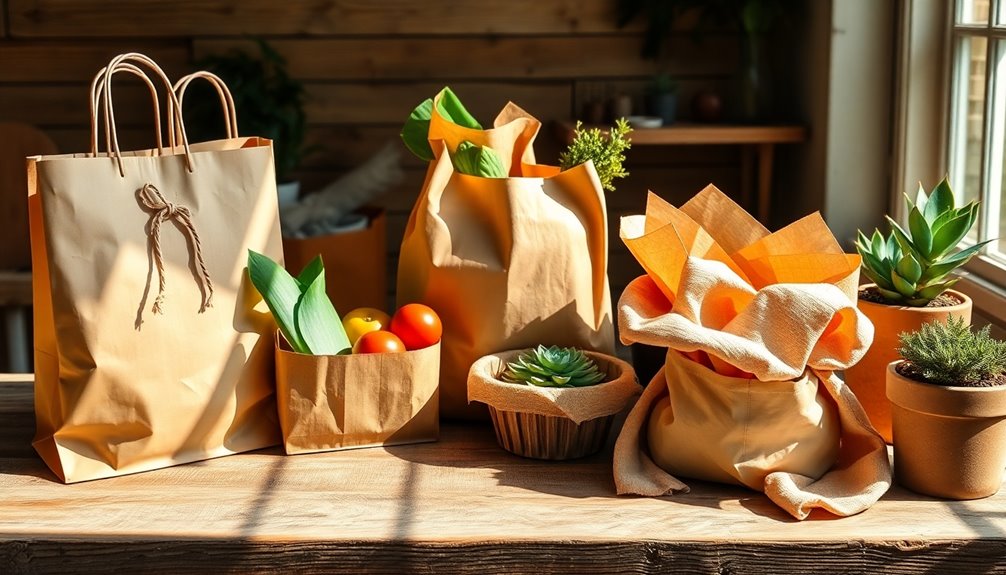When shopping, you can make eco-friendly choices by understanding material types, like biodegradable or recycled options. Always look for certifications such as FSC or Green Seal, which indicate responsible sourcing. Prioritize reusable packaging, opting for items you can use multiple times. Consider package size and design; minimalistic options can reduce waste while being visually appealing. Research brand practices to guarantee they're committed to sustainability and transparency. By making informed choices, you'll contribute to a healthier planet and support eco-conscious brands. Stick around to discover more practical tips on enhancing your sustainable shopping experience.
Key Takeaways
- Look for biodegradable, compostable, or recycled materials in packaging to minimize environmental impact.
- Seek out brands with third-party certifications that confirm their eco-friendly claims and sustainable practices.
- Prioritize reusable packaging options to reduce waste and foster sustainable habits in your shopping routine.
- Choose brands that offer carbon-neutral shipping and support local businesses to lessen transportation-related emissions.
- Avoid excessive packaging and single-use plastics by opting for products with minimal and efficient packaging design.
Understand Material Types
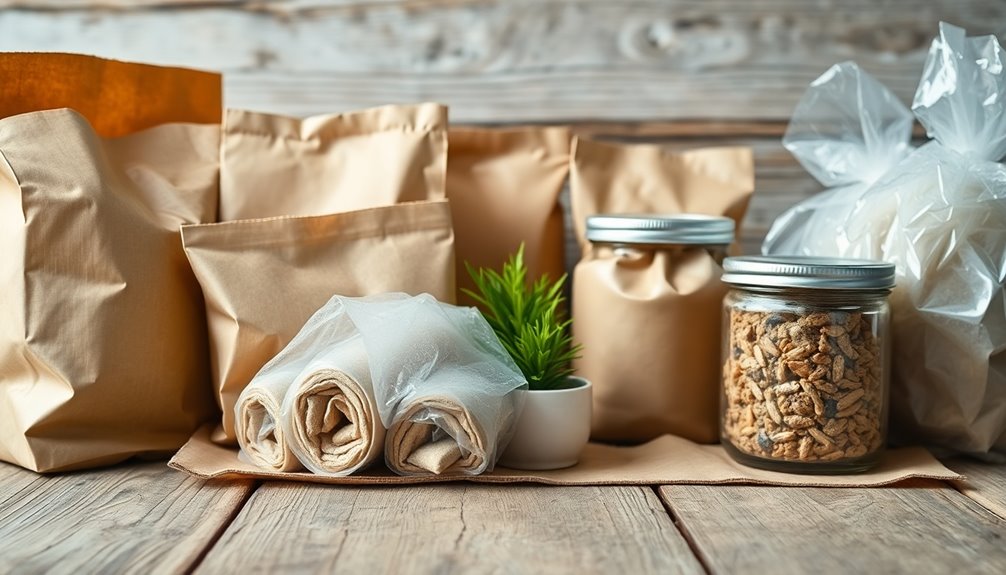
When you're shopping for eco-friendly packaging, grasping the diverse material types available is crucial. This knowledge not only empowers you but also connects you to a community that values sustainability. You'll find a variety of sustainable options, each with its unique environmental impact.
For instance, consider biodegradable materials like cornstarch-based plastics or paper products. These options break down naturally, reducing landfill waste and pollution.
If you're looking for a more durable solution, recycled cardboard or paper can be excellent choices, as they minimize the need for virgin materials and showcase a commitment to circular economies.
Another sustainable option is glass, which is infinitely recyclable and can markedly lower your carbon footprint. While it may be heavier, the benefits of using glass often outweigh the downsides, especially if you intend to reuse it.
Then there's the rising star of the eco-friendly packaging world: compostable materials. These are designed to break down in composting facilities, enriching the soil instead of contributing to environmental degradation. However, it's fundamental to make sure that these materials are disposed of correctly to maximize their benefits. Moreover, just as traditional bread consumption can lead to significant health impacts, opting for eco-friendly materials can greatly reduce your environmental footprint.
Ultimately, understanding these material types helps you make informed choices that align with your values. When you choose eco-friendly packaging, you're not just making a purchase; you're participating in a movement towards sustainability and environmental stewardship. So, as you shop, think critically about the materials you select and their broader implications for our planet.
Look for Certifications

Understanding the variety of eco-friendly materials is just the beginning; looking for certifications can greatly enhance your shopping choices. When you're endeavoring to make a positive environmental impact, certifications act as reliable indicators of a product's sustainability. They provide you with the assurance that the packaging you choose meets specific environmental standards, which can elevate your consumer awareness and guide you toward better decisions.
Look for widely recognized certifications like FSC (Forest Stewardship Council) for responsibly sourced paper or plastic alternatives marked with the "Green Seal." These labels signify that the product adheres to rigorous environmental criteria, ensuring that it's not only less harmful but also contributes to responsible sourcing practices. By prioritizing certified packaging, you're not just making a purchase; you're supporting a movement that values transparency and responsibility.
Moreover, understanding these certifications can foster a sense of belonging within a community of like-minded shoppers. You're part of a growing population that actively seeks to reduce waste and minimize environmental footprints. By choosing certified products, you're sending a clear message to manufacturers that sustainability matters, motivating them to adopt more eco-friendly practices. Additionally, just as mini bands offer a wide variety of sculpting movements for effective muscle toning, eco-friendly packaging alternatives provide diverse options that can fit various consumer needs.
Next time you shop, take a moment to examine the packaging's certifications. This small step can lead to significant changes in your purchasing habits and contribute to a larger impact on our planet. Together, we can create a world where eco-friendly choices are the norm, not the exception.
Prioritize Reusability
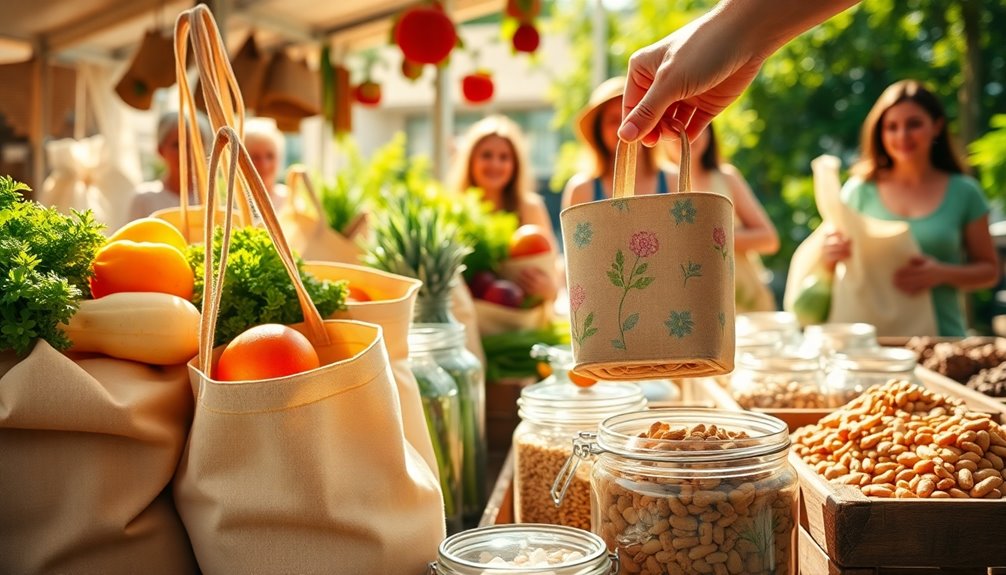
Reusability should be at the forefront of your eco-friendly shopping strategy. When you prioritize reusable packaging, you're making a significant commitment to reducing waste in our environment. Think about it: every time you choose a product with reusable packaging, you're not just buying an item; you're opting for a sustainable option that contributes to a healthier planet.
Consider using bags, containers, or wraps that can be utilized multiple times. By doing so, you actively participate in a cycle that minimizes the need for single-use plastics and other disposable materials. This shift not only lessens your ecological footprint but also promotes a culture of sustainability that others can adopt.
When shopping, look for brands that encourage reusability through their packaging designs. Many companies are now offering innovative solutions that allow you to refill products or return packaging for reuse. This not only makes you part of a community committed to eco-friendliness, but it also sets a standard for others to follow.
Additionally, you can take it a step further by investing in your own reusable containers and bags. Make it a habit to carry them with you, so you're always ready to say no to unnecessary waste. Adopting plant-based diets can further complement your eco-friendly efforts by significantly reducing greenhouse gas emissions.
Consider Size and Design
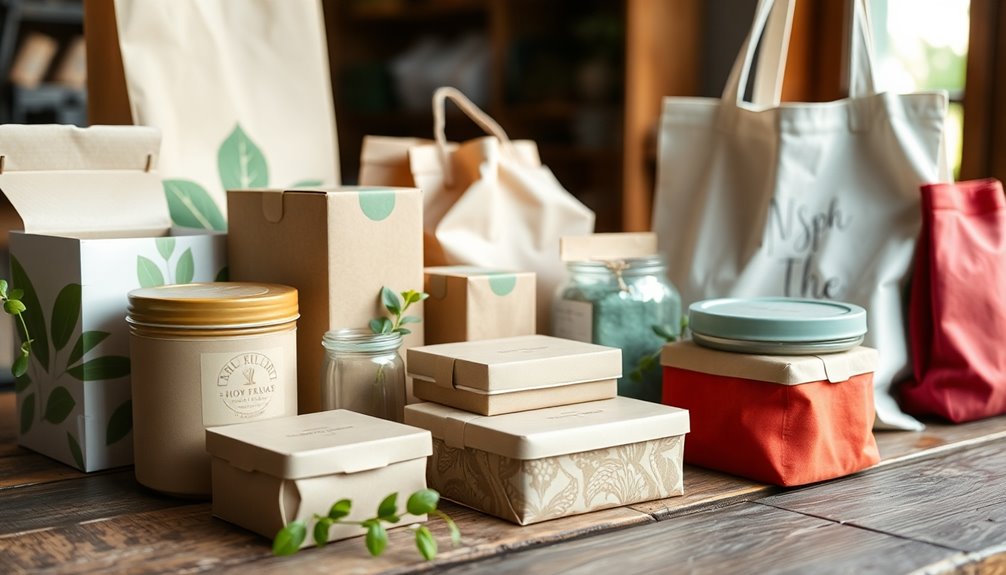
Choosing the right size and design of packaging can make a substantial difference in your eco-friendly shopping experience. When you consider both the environmental impact and aesthetic appeal, you're not just making a purchase; you're making a statement. Smaller, well-designed packaging often reduces waste and can enhance the visual appeal of your products.
Here's a simple breakdown of how size and design can influence your choices:
| Aspect | Benefits | Considerations |
|---|---|---|
| Size | Reduces material use | Make sure it fits your needs |
| Design | Enhances visual appeal | Opt for minimalistic designs |
| Eco-friendly materials | Biodegradable or recyclable options | Check for certifications |
Additionally, choosing packaging made from eco-friendly materials can significantly lessen your carbon footprint and promote sustainability.
Research Brand Practices
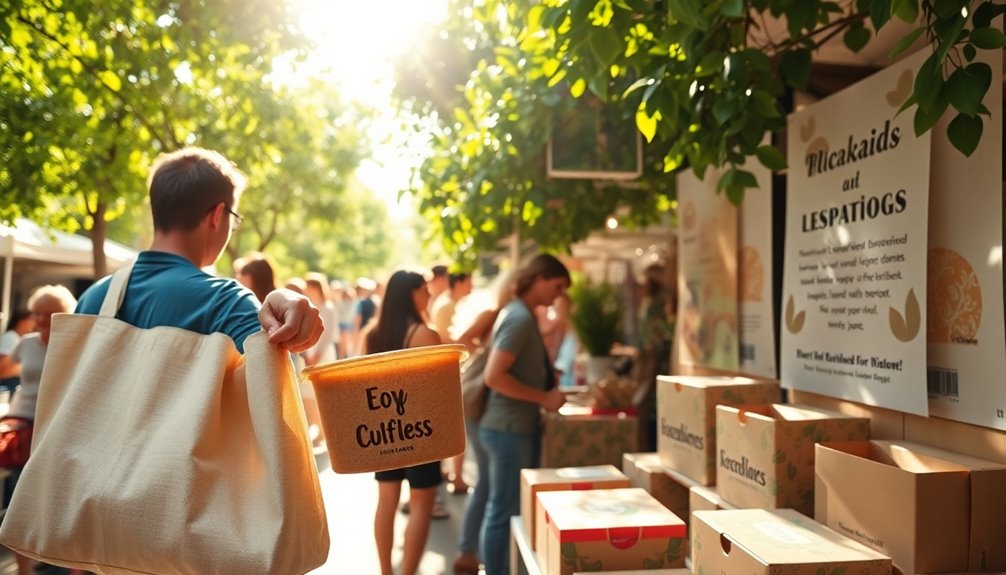
Examining brand practices is essential when aiming for eco-friendly shopping. By researching the brands you support, you can better understand their ethics transparency and sustainability impact. Many companies claim to be eco-friendly, but the reality often falls short. Digging deeper into their practices can reveal whether their packaging genuinely aligns with your values or if it's just greenwashing.
Start by looking for brands that openly share their sustainability goals and progress. Are they transparent about the materials they use and their sourcing methods? Brands that provide clear information about their supply chain and environmental commitments often demonstrate a genuine dedication to sustainability. This transparency builds trust and helps you feel like you're part of a community that prioritizes responsible consumption.
Additionally, check for third-party certifications that validate a brand's claims. Certifications like FSC (Forest Stewardship Council) for paper products or Cradle to Cradle can signal that a company is serious about its environmental impact. Notably, some brands are also focusing on reducing health risks associated with their products, similar to how snoring solutions address specific problems.
Engaging with brands on social media and reading reviews can also help you gauge public perception of their practices. When you support brands that prioritize ethics and transparency, you contribute to a larger movement towards sustainability. You're not just making a purchase; you're joining a community that values responsible choices.
Frequently Asked Questions
What Are the Environmental Impacts of Plastic Packaging?
Plastic packaging plays a key role in plastic pollution, harming ecosystems and wildlife. You mightn't realize that every piece of plastic ever made still exists in some way. Reduction efforts are vital; by minimizing plastic use, you help protect the environment and promote sustainability.
Engaging in responsible shopping habits creates a sense of belonging within a community that values eco-friendliness. Together, we can reduce our footprint and foster a healthier planet for future generations.
How Can I Identify Biodegradable Materials?
Identifying biodegradable materials isn't just about what it is; it's about what it can become. Look for labeling that specifies "compostable" or "biodegradable." Understanding recyclable symbols can help too—those marked with the chasing arrows often indicate materials that can break down safely.
Are There Specific Brands Known for Eco-Friendly Packaging?
When you're looking for brands that prioritize eco-friendly packaging, consider those committed to sustainable options. Many companies are now adopting innovative solutions, like compostable materials and minimalistic designs.
Brands such as Uncommon Goods and Patagonia lead the way, demonstrating their dedication to the environment. By supporting these brands, you're joining a community that values sustainability and responsible consumption, making a positive impact on our planet while enjoying your shopping experience.
What Are Common Misconceptions About Eco-Friendly Packaging?
You might think all eco-friendly packaging is the same, but that's not true. A common misconception is that all biodegradable options are compostable; they're not.
Compostable packaging offers significant benefits, breaking down into nutrient-rich soil. However, watch out for greenwashing in sustainability, where brands falsely claim eco-friendliness.
Conduct research and choose genuinely sustainable products to support the environment and align with your values, ensuring your choices truly make a difference.
How Can I Properly Dispose of Eco-Friendly Packaging?
To properly dispose of eco-friendly packaging, you'll want to know your recycling options first. Check local guidelines, as not all materials are recyclable in every area.
If you're dealing with compostable materials, make sure they go to a commercial composting facility, as home composting mightn't break them down effectively.
Conclusion
By choosing eco-friendly packaging, you're not just making a purchase; you're participating in a movement toward sustainability. Picture vibrant forests and clear oceans, thriving thanks to your mindful decisions. Every box you select, every bag you carry, reflects your commitment to a healthier planet. As you navigate aisles, remember that your choices ripple through the environment, shaping a greener future. So, embrace packaging that speaks to your values, and let your shopping reflect the world you want to see.

